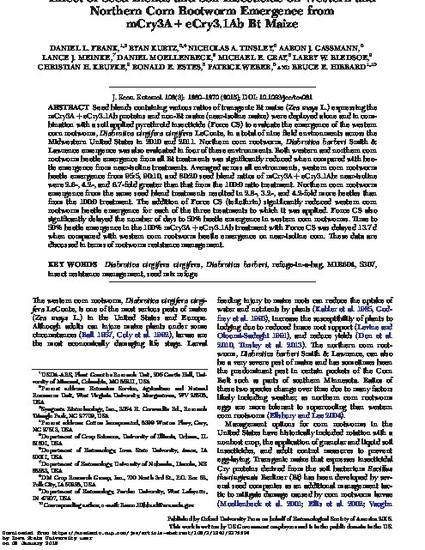
Seed blends containing various ratios of transgenic Bt maize ( Zea mays L.) expressing the mCry3A + eCry3.1Ab proteins and non-Bt maize (near-isoline maize) were deployed alone and in combination with a soil applied pyrethroid insecticide (Force CS) to evaluate the emergence of the western corn rootworm, Diabrotica virgifera virgifera LeConte, in a total of nine field environments across the Midwestern United States in 2010 and 2011. Northern corn rootworm, Diabrotica barberi Smith & Lawrence emergence was also evaluated in four of these environments. Both western and northern corn rootworm beetle emergence from all Bt treatments was significantly reduced when compared with beetle emergence from near-isoline treatments. Averaged across all environments, western corn rootworm beetle emergence from 95:5, 90:10, and 80:20 seed blend ratios of mCry3A + eCry3.1Ab: near-isoline were 2.6-, 4.2-, and 6.7-fold greater than that from the 100:0 ratio treatment. Northern corn rootworm emergence from the same seed blend treatments resulted in 2.8-, 3.2-, and 4.2-fold more beetles than from the 100:0 treatment. The addition of Force CS (tefluthrin) significantly reduced western corn rootworm beetle emergence for each of the three treatments to which it was applied. Force CS also significantly delayed the number of days to 50% beetle emergence in western corn rootworms. Time to 50% beetle emergence in the 100% mCry3A + eCry3.1Ab treatment with Force CS was delayed 13.7 d when compared with western corn rootworm beetle emergence on near-isoline corn. These data are discussed in terms of rootworm resistance management.
Available at: http://works.bepress.com/aaron_gassmann/69/

This article is published as Frank, Daniel L., Ryan Kurtz, Nicholas A. Tinsley, Aaron J. Gassmann, Lance J. Meinke, Daniel Moellenbeck, Michael E. Gray et al. "Effect of seed blends and soil-insecticide on western and northern corn rootworm emergence from mCry3A+ eCry3. 1Ab Bt maize." Journal of economic entomology 108, no. 3 (2015): 1260-1270. doi: 10.1093/jee/tov081. Posted with permission.